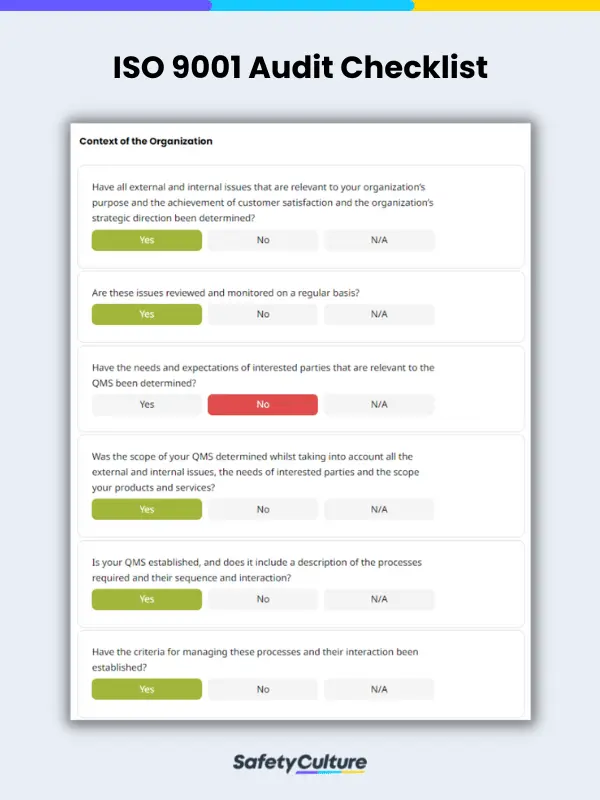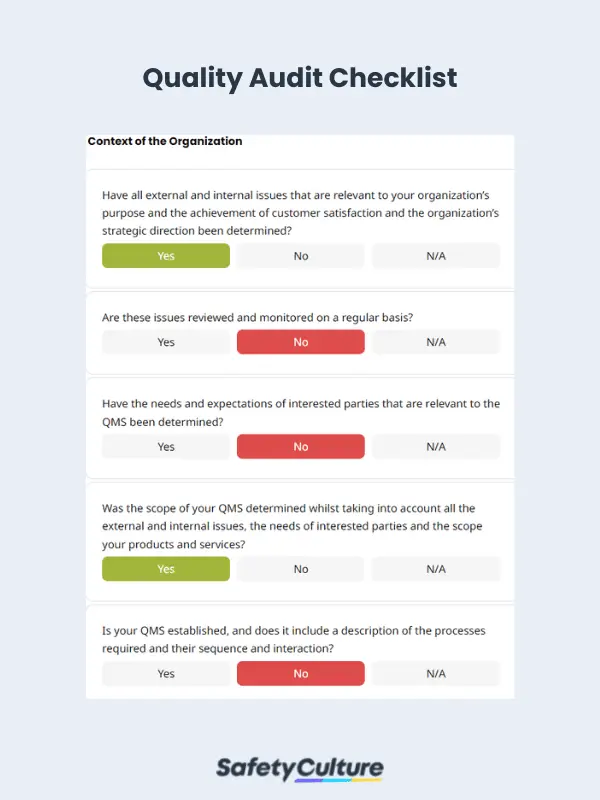What is a Quality Audit?
A quality audit is the systematic examination of an aspect of business to assess conformance with a standard. Conducted by a team of internal or external auditors, passing a quality audit provides assurance that an organization’s products and/or processes are at par with recognized industry standards and compliant with regulations.
Quality audits are vital to any business because they provide the opportunity to improve processes that can result in better products and services. Passing quality audits allow businesses to operate with the recognition that they are aligned with industry standards (such as ISO-9001) and they can partner with other organizations with shared expectations on quality.
What is the Quality Audit Process?
As a systematic process of determining an organization’s alignment with industry standards, a quality audit follows these 5 stages:
Preparation
Preparing for an audit entails the forming of an auditing team with an audit plan, identifying audit objectives, determining the scope, knowing the audit criteria, preparing audit checklists, and informing the auditee or client (if third-party auditor) of the timeframe of the audit to be conducted.
Audit Execution
The audit is conducted by the team of auditors executing their tasks such as information gathering using the quality audit checklists and other work documents they have prepared.
Audit Report
Audit findings are analyzed and submitted to the auditee, providing feedback and recommendations as well as any corrective actions that the auditee needs to work on in order to meet the standard.
Corrective Action
Corrective actions are the responsibility of the auditee and are intended to address gaps in conformance with standards.
Follow-up
The follow-up stage involves the auditor checking on the auditee’s progress on working on the corrective actions. It determines if gaps have been addressed by implemented corrective actions and the organization’s status of compliance after implementation.
Quality Control Audit and Quality Assurance Audit
When it comes to QC audit and QA audit, both involve the same audit process conducted by auditors who are tasked to determine if products (QC) or processes (QA) are meeting set standards.
Common Issues or Failures in Quality Audits
Quality audits are conducted to discover failures or opportunities to improve in order to meet quality standards. Here are 3 of the common failures encountered in quality audits:
Technical
Some examples of technical failure in quality audits come in the form of unorganized documentation and the state of a facility. Providing proof of consistent quality requires ample and organized documentation. Technical failure in the factory or facility can be a result of the poor layout of the production floor and the quality of equipment used.
Social
Social failure usually involves non-compliance with acceptable working conditions. Workplaces that don’t meet safety regulations and have unacceptable labor practices like child labor are glaring fails in quality audits. Poor labor practices of suppliers or anyone involved in the supply chain can entail social failure for the organization being audited even if they are not directly responsible for the deficiencies in labor practices.
Another example of social failure can be something as basic and crucial as the proper wearing of personal protective equipment (PPE) in the workplace. Proactively reinforcing safety practices can help avoid social failures in quality audits.
Environmental
Businesses have a responsibility to minimize their negative impact on the environment. Organizations are expected to have processes in place for proper waste disposal and storage of toxic substances. Lack of controls to mitigate environmental impact can result in quality audit failures.
What are 3 Types of Quality Audits?
According to the American Society for Quality, there are 3 types of quality audits: process audit, product audit, and system audit.
1. Process Audit
Process quality audits examine process conformance to set standards. This type of audit may include auditing resources as well as defined requirements within processes such as weights, times, and other measurements. Process quality audits also assess the effectiveness of process controls through work instructions, employee training, and more.
2. Product Audit
Product quality audits examine output such as products or services to determine if they are performing according to customer specifications and are meeting quality standards.
3. System Audit
System quality audit examines the quality of a management system to ensure it is indeed effective and performing according to expectations. Examples of system audits performed are for examinations of quality management programs, environmental management system, food safety management system, and safety management system.
Who Performs Quality Audits?
There are different types of audits according to who performs them and the intention for conducting the audits.
First-party Audit
First-party audits are conducted by the organization itself usually to assess its current standing against an existing standard in order to discover gaps that can be corrected. Usually performed in preparation for getting a third-party audit for certification, this internal quality audit is done by employees and is designed to be objective in order to uncover areas for improvement.
First-party audits also help establish benchmarks of the internal audit activity that can be used to establish metrics. Over time, these metrics will indicate improvement in areas of partial conformance or nonconformance with standards and successful practices.
Second-party Audit
Second-party audits are conducted on suppliers by a customer or by an organization on behalf of a customer. It is conducted as a contractual obligation for a transaction that determines purchases or deals to be made by a customer.
Third-party Audit
Third-party audits are performed by recognized independent audit organizations that are not affiliated with the business being audited. They are authorized to provide recognition or certification that an organization indeed meets a certain standard after being audited.
What is a Quality Audit Checklist?
A quality audit checklist is a tool that guides auditors, quality managers, inspectors, or an assigned person in auditing products or business procedures. It helps assess the performance of established processes and identify any underlying issues that require corrective actions. Performing regular quality audits can help maintain the quality of products, boost business efficiency, and improve business strategies while maintaining conformance with existing standards.
Quality Audit Checklist Phases
Below are the phases of using a quality audit checklist for quality audits:
- Identify audit objectives.
- Determine audit scope.
- Conduct the audit.
- Report audit findings.
- Provide corrective action.
- Check progress of corrective action.
- Determine if gaps have been addressed.
- Update status of compliance.



